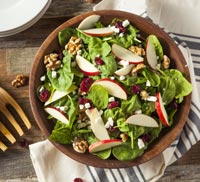Take the Stress Out of Preparing Your Thanksgiving Turkey
Safety tips on preparing the perfect Thanksgiving turkey for the holidays.
 Nashville, Ark. – As the Thanksgiving holiday approaches, you have probably given
some thought to what you will prepare, how you will prepare it, who is coming and
the list goes on and on.
Nashville, Ark. – As the Thanksgiving holiday approaches, you have probably given
some thought to what you will prepare, how you will prepare it, who is coming and
the list goes on and on.
Regardless of whether this is your first Thanksgiving or the fiftieth, preparing the holiday bird can be stressful. It doesn’t have to be that way. Here are few steps to follow to ensure you have a delicious Thanksgiving meal for you, your family and your friends.
What should I look for when buying my turkey?
There are some things to consider when purchasing the turkey. Most of the turkeys we have available come to us frozen, so let’s address that option.
Now is the time to purchase the turkey. You will need to allow several days for the turkey to thaw in your refrigerator, so make sure you have enough room in the fridge to thaw it properly.
Plan Ahead for Turkey Thawing Time
Be sure to plan ahead – it takes approximately 3 days for a 20 pound turkey to fully defrost in the refrigerator. Place the turkey on the bottom shelf with a pan under it to catch any liquids that will pool as the turkey thaws. Avoid thawing in the kitchen sink or on the counter. Bacteria, which are present, in the turkey will grow at an alarming rate. By thawing in the refrigerator at a temperature below 40 degrees, bacteria will not grow as fast.
How long should I cook my turkey?
Determining how long to cook your bird can also be difficult. Plan on 20 minutes per pound in a 350 degree F oven for a defrosted turkey. That means if your turkey is 20 pounds, you will need to allow about 4 ½ hours to cook.
To Stuff or Not to Stuff Your Turkey
Although many people picture the ideal turkey as one put on the table with the stuffing inside, a turkey will cook more evenly if it is not densely stuffed. Consider adding flavor by loosely filling the cavity with aromatic vegetables – carrots, celery, onion or garlic – or by carefully tucking fresh herbs underneath the breast skin. Rosemary or thyme are great herbs to use. For the stuffing lovers, cook the dressing in a casserole dish on the side.
Before you begin roasting, coat the outside of the turkey with vegetable or olive oil, season with salt and pepper and tightly cover the breast with aluminum foil to prevent over-browning. Once you get the turkey in the oven, resist the temptation to open the oven door. When the oven temperature fluctuates, you’re only increasing the likelihood of a dry bird. About 45 minutes before the turkey is done, remove the foil from the breast to allow it to brown.
Check internal temp with a food thermometer!
Use a food thermometer to check the internal temperature of the turkey and assure a moist bird. A whole turkey is safe when cooked to a minimum internal temperature of 165 degrees F throughout the bird. Check the temperature in the innermost part of the thigh and wing and the thickest part of the breast. All turkey meat, including any that remains pink, is safe to eat as soon as all parts reach at least 165 degrees F. The stuffing should reach 165 degrees F, whether cooked inside the bird or in a separate dish.
When the turkey has reached the correct temperature and you are ready to remove it from the oven, let it stand sitting out for 20 minutes. Then you can remove the stuffing and carve. This should give you plenty of time to make gravy, and finish up any side dishes.
Tips for Storing Leftovers Properly
Once you have enjoyed your meal, don’t forget to store your leftovers properly. Cut your turkey into small pieces; refrigerate stuffing and turkey separately in shallow containers within 2 hours of cooking. Use leftover turkey and stuffing with 3-4 days; gravy within 1-2 days; or freeze these foods. Reheat any leftovers thoroughly to a temperature of 165 degrees F or until hot and steaming.
Check out these tips for using your Thanksgiving leftovers.
Preparing your holiday bird can be an enjoyable, stress-free task if you heed some of the tips mentioned above. Talking Turkey is a free handout available that provides information such as what size turkey to purchase, thawing methods, cooking times for both stuffed and unstuffed birds according to the size of your turkey, and more.
If you would like to receive this information, contact the Howard County Cooperative Extension Service at 870-845-7517 or visit our office located on the second floor of the courthouse. The Cooperative Extension Service is part of the University of Arkansas System Division of Agriculture.
You can also download this information as a handout.
Enjoy your Thanksgiving meal with family and friends!
Recipe of the Week: Holiday Honeycrisp Salad
 If you are looking for a new salad recipe to try this holiday season, try this one.
It uses fresh apple slices, toasted pecans, cranberries, and a sweet-tangy vinaigrette
dressing.
If you are looking for a new salad recipe to try this holiday season, try this one.
It uses fresh apple slices, toasted pecans, cranberries, and a sweet-tangy vinaigrette
dressing.
Make the vinaigrette dressing and toast the pecans a couple of days before the big meal to save time. Refrigerate dressing after making and allow to come to room temperature before serving.
-
½ cup extra-virgin olive oil
-
¼ cup apple cider vinegar or red wine vinegar
-
¼ cup apple juice
-
2 to 3 Tablespoons honey
-
1 Tablespoon lemon juice
-
½ teaspoon salt
-
Freshly ground black pepper to taste
-
3 medium Honeycrisp apples thinly sliced
-
12 ounces spring mix salad greens
-
1 cup pecan halves, toasted
-
¾ cup dried cranberries
-
4 ounces Feta cheese
-
To make the dressing, combine olive oil, vinegar, apple juice, honey, lemon juice, salt and pepper in a small jar with a lid.
-
Shake vigorously until mixture is well combined. Set aside.
-
To make the salad, layer salad greens, apple slices, pecans, cranberries and Feta cheese in a large bowl.
-
Just before serving, pour desired amount of vinaigrette dressing on salad and toss until salad is evenly coated.
-
Caution: You can prevent apples from turning dark by letting the slices sit in lemon juice or lemon-lime soda for a few minutes. Drain and set aside until ready to serve.
By Jean Ince
County Extension Agent - Staff Chair
The Cooperative Extension Service
U of A System Division of Agriculture
Media Contact: Jean Ince
County Extension Agent - Staff Chair
U of A Division of Agriculture
Cooperative Extension Service
421 N. Main St, Nashville AR 71852
(870) 845-7517
jince@uada.edu